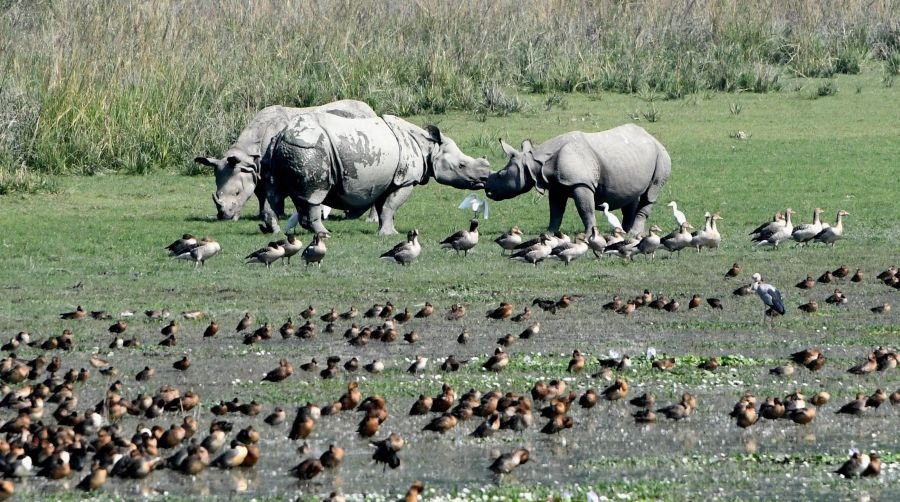By: Dipak Kurmi
When one envisions a forest, the focus often turns to the importance of preserving genetic diversity, the undiscovered medicinal potential of its plant life, and the captivating beauty of a vibrant and diverse ecological entity. The debate between monoculture and biodiversity in forest plantations holds significant weight, not just within academic circles but also among scientists, conservationists, and the general public. A forest ecosystem represents more than just a collection of organisms; it’s a complex network of interactions shaped by environmental factors. The forest floor and its vegetation play a crucial role in nutrient recycling, ensuring the ecosystem’s resilience following disturbances. Ultimately, at the heart of the matter lies the concept of sustainability. A sustainable forest is one that continues to provide its ecological benefits and maintains its overall health, even in the face of human intervention.
According to the Forest Survey of India’s 2021 report, there has been a modest increase of 31 sq. km. in forest cover within the officially recorded forest areas of India. However, a closer examination of the data reveals concerning trends: there has been a significant decline of 1582 sq. km. in moderately dense forests within the total recorded forest area of the country. In contrast, there has been an increase of 2621 sq. km. in open forest area and 5320 sq. km. in scrub area. Additionally, an increase of 1509 sq. km. in forest cover has been reported outside the recorded forest areas. The conversion of agricultural land into forest plantations often brings ecological benefits. On the other hand, natural forests that are degraded or replaced by monoculture plantations lose their diverse and intricate biodiversity. India has witnessed the expansion of plantations along transportation corridors such as roads, railways, and canals, occasionally displacing indigenous vegetation. There are also instances of grassland ecosystems being converted into tree plantations under various government programs that promote “greening” efforts in pursuit of setting tree planting records.
Outside of officially recorded forest areas, plantations typically involve the cultivation of a single or a limited number of species, primarily for commercial purposes such as timber production, pulp, fuelwood, and fodder. While these monocultures can yield economic benefits, they bring about significant environmental consequences, particularly in relation to biodiversity. One immediate consequence of establishing such plantations is the loss of native plant species, although there have been reported instances where some native species reemerge over time, albeit in smaller quantities. Plantations often fragment existing natural habitats and have a substantial impact on species that require larger territories, specific migratory routes, or depend on a diverse diet and nutritional resources provided by biodiverse environments.
Monocultures can become breeding grounds for pests and diseases that specifically target the planted species. In the absence of natural predators or competitors, these pests can thrive, often necessitating the use of chemical pesticides, which further harm the ecosystem. Furthermore, monocultures can deplete specific nutrients from the soil, reducing its fertility over time, which in turn affects the regulation of the water cycle and disrupts local water tables. Carbon sequestration in monoculture plantations is also less effective compared to biodiverse areas.
India’s history of forest management reflects the use of advanced silvicultural principles as a key component of its conservation strategy. The management approach aimed to maintain a balance between the harvestable volume within the managed area and the annual increment of the forest. Robust silvicultural systems were in place, offering a range of management tools based on specific objectives, taking into account factors such as the species, crop density, and the economic and local community needs for forest products. The fundamental principle of respecting the forests’ carrying capacity was considered non-negotiable.
The calculations for determining annual forest yields were based on the assumption that the forests would be effectively protected, free from any illegal removal of forest resources. In forested areas, plantation efforts were initiated to complement natural regeneration and enhance the productivity of degraded sections. As outlined in the Forest Policy of 1988, the primary priority for forest resources was to fulfill the domestic needs of tribal and underprivileged communities. Any shortfall in such resources was addressed by establishing plantations outside of forested regions. This system functioned well until the growing human population began to exert an anthropogenic impact that exceeded the forests’ carrying capacity.
The increasing demands on forests, driven by both economic requirements and the needs of local communities, combined with a rapid erosion of control mechanisms, ultimately undermined the successful implementation of scientific forestry principles on the ground. The insistence on professional forest and wildlife management, along with the strict enforcement of control measures, was sometimes viewed as an attempt by the forestry sector to maintain dominance, despite being a response to the increasingly complex interactions between humans, forests, and wildlife over time.
Ensuring the sustainability of forests and biodiversity, along with the continued provision of related ecological services to a broader range of stakeholders, necessitated the development of a well-researched and updated forest management system. The response to this need took the form of a shift towards democratizing forestry practices. In the 1990s, the concept of participatory forest management was introduced, and later, the idea of granting forest management responsibilities exclusively to village communities was implemented through the Forest Rights Act of 2006 and state-specific Rules under the Panchayats (Extension to the Scheduled Areas) Act of 1996.
Under these arrangements, village communities are mandated to manage forests, wildlife, and minor forest produce, as well as prepare management plans for the areas in their proximity. These activities are overseen by Gram Sabhas, with the Forest Rights Rules of 2012, as notified by the Ministry of Tribal Affairs, excluding the forestry sector’s direct involvement in these matters.
India’s traditional approach to landscape-based forest and wildlife management, which supported expansive ecosystems, wildlife corridors, biodiversity networks, watersheds, and large catchment areas, is undergoing a transformation. It is evolving into a patchwork of micro-units of forest management, each specific to individual villages and determined by local communities. Some state tribal departments have even mandated that village-level micro-plans take precedence over the landscape-based working plans of the forestry sector. Despite a majority of the currently recognized management rights not aligning with these provisions, these changes are likely to have adverse effects on biodiversity conservation.
While intensive silviculture and enhanced biodiversity can coexist, it requires a refined silvicultural system, objectives tailored to specific ecosystems, and a landscape-level approach. Unfortunately, the latest framework prescribed for forest management in the country does not adequately fulfill these requirements.
Human-made plantations established outside officially recorded forest areas serve important economic purposes, but their long-term sustainability raises concerns due to their adverse impact on biodiversity and ecosystems. However, there are alternative approaches, such as agroforestry, the creation of biodiversity corridors within plantations, adopting mixed-species planting, interspersing long-rotation crops with short-rotation ones, preserving original vegetation patches or introducing diverse shrubs and trees, maintaining wider spacing and thinning to promote floral and avian diversity, avoiding the use of herbicides to support invertebrate populations, conserving large trees to provide habitats for birds, and retaining woody debris after logging to enhance amphibian and invertebrate diversity. These approaches can be viable and effective strategies for conserving biodiversity even in areas outside officially recorded forests.
In a nation already grappling with pressing issues like water scarcity, environmental decline, and the impacts of climate change, the information presented in the FSI’s 2021 report strongly underscores the necessity for a fundamental shift in India’s approach to forest and biodiversity preservation. The path forward involves seeking inventive solutions that harmonize the dual goals of economic viability and conservation, ensuring that progress does not come at the detriment of our planet. (The writer can be reached at dipaknewslive@gmail.com)







